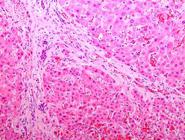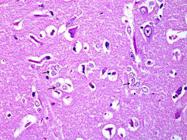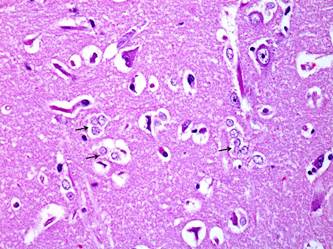ABSTRACT:
Poisoning due to plants of the genus Senecio is considered an important cause of death in livestock. Senecio brasiliensis is the most common species involved in spontaneous cases. This paper describes the epidemiological, clinical and pathological aspects of a natural outbreak of intoxication with Senecio brasiliensis affecting two out of eighteen horses in a farm. The cases occurred in the municipality of Sao Martinho da Serra, Rio Grande do Sul State, Southern Brazil. A large amount of Senecio brasiliensis in its sprouting stage was found in the fields where the horses used to be kept. A four-year-old, Crioulo mare and a five-month-old, male, Crioulo foal were affected. The clinical course was acute in the mare, comprising three days and chronic in the foal, lasting for two months. The main clinical signs in both animals included apathy, anorexia, weight loss, dehydration and neurological signs. Moreover, subcutaneous edema was noted in the ventral abdomen and the mucous membranes were icteric in the mare and pale in the foal. The serum biochemistry in the foal showed hypoalbuminemia (2.1g/dL), increased activity of the serum alkaline phosphatase (434 U/L) and gamma glutamyl transferase (119 U/L). In the hemogram, a mild normocytic normochromic anemia was noted in the foal (Hct: 30%; MCV: 39.5 fL; MCH: 15.3pg). Necropsy findings observed in both horses included an enlarged, dark red and firm liver with extensive areas of hemorrhage and enhanced lobular pattern on cut surface. Histologically, the liver showed variable degrees of fibrosis, coagulative necrosis, biliary ducts hyperplasia, megalocytosis and cholestasis. In the brain, the astrocytes in the cerebrum were degenerated and similar to Alzheimer type II astrocytes. The diagnosis in this outbreak was established based on the epidemiology, clinical picture, gross and histologic findings. It is noteworthy that the coagulative necrosis, minimal fibrosis, and biliary duct hyperplasia observed in the mare are characteristic of a subacute presentation. On the other hand, the fibrosis that was more prominent in the foal characterizes a chronic hepatopathy.
INDEX TERMS:
Equine diseases; hepatotoxic plants; Asteraceae; Senecio brasiliensis; pyrrolizidine alkaloids; pathology; poisonous plants; plant poisoning.

 Thumbnail
Thumbnail
 Thumbnail
Thumbnail
 Thumbnail
Thumbnail
 Thumbnail
Thumbnail



